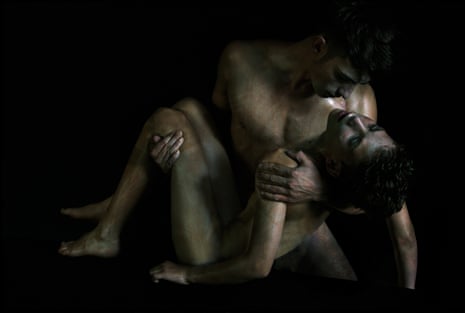The first time I was captivated and transported by art was when I saw my first Bill Henson photograph. I was 21. The piece – it belonged to a friend’s sister – produced a sudden surge of tenderness, nostalgia and yearning all at once. I couldn’t afford to buy an original but saved all my money and bought his book. In it was Melbourne, but not as I knew it.
One of his early works I loved featured two pale bodies in a dark, industrial wasteland. Illuminated, sheared-off pieces of tin and scrap metal gave the impression of angels’ wings on a shirtless boy and girl. They looked filthy and abandoned yet also transcendent. It was a photograph shot in Melbourne in the 90s but it could have been a Caravaggio.
Sign up to receive the top stories in Australia every day at noon
Henson is fully aware of the effect his work has on audiences. “It affects people in a way, emotionally, that at the outset is only partially apprehended or understood,” he says.
“People would come up to me with old shopping bags of catalogues from the 90s and 80s – and they’re from Russia or from Argentina or somewhere – and they say, ‘I’ve been following you for 30 years.’ They’ve been on their own private journeys.”
So it is not surprising to him that, when I turn up to meet him at his home in the Melbourne suburb of Northcote, I bring my enormous, prized copy of his book Lux et Nox, published in 2002 and survivor of a dozen house moves.
In a converted grocery warehouse, behind a high gate, Henson lives with his partner, the artist Louise Hearman. They share the compound with their Staffordshire terrier, Mr Pigs. When I am buzzed inside, Hearman tells me that Henson has gone to the shop to get a Cherry Ripe, and I’m led into an extraordinary space that looks part-Harry Potter, part-medieval library, part-man cave. The walls are painted brown-black and the library stretches over two floors.
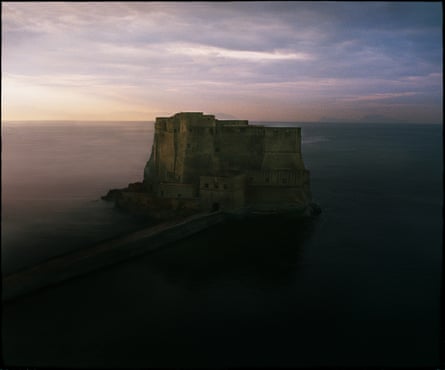
This is also Henson’s studio and, as I am left alone to wander among huge prints from various points in his four-decade career (he had his first solo show in at the National Gallery of Victoria aged 19), the sensation is almost vertiginous. It’s like Aladdin’s cave but the treasures are these enormous, dark, yet carefully lit pieces of art. They also indicate that, apart from a few minor shifts, Henson’s style has been remarkably consistent. The level crossing late at night. An old bridge. A dark mountain looming. A crumbling overpass. Dark-haired teens with pale, slender bodies and private, ambiguous expressions.
Henson is one of Australia’s best-known and greatest living artists and, as a result of tabloid scandal over the use of nude adolescents in his work, one of its most controversial. But more on that later.
He is about to launch a new exhibition at Melbourne’s Tolarno Galleries. There are some works shot in Tuscany and a couple of male nudes, lit and arranged like classical sculpture. The boy’s skin almost looks marbled, like a slab of wagyu beef. Again in these works there is that thick, velvety background, both mesmeric and beckoning.
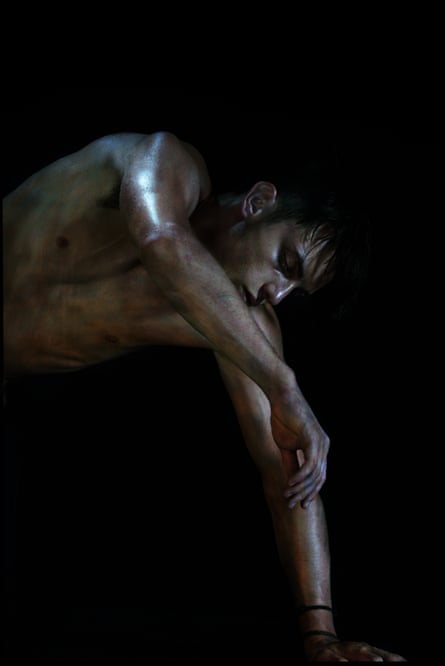
Having returned from his chocolate-buying expedition, Henson, a fit-looking 62, takes a seat at his desk in the massive library. Hearman brings us white wine, which we sip in the gloom. Henson’s abiding interest is in how modern life conspires against stillness and silence.
“There is a curious thing to do with tech and the way we live our lives now,” he says. “You could say it’s accelerating. Still things – things which do not move or make noise – are having a harder time of it. That contemplative state is a harder thing to do, a harder place to find yourself in than it might have been in the past.”
He uses the example of reading ebooks in comparison with print. “Your attention is always broken, there is always the distraction at the periphery,” he says. “So it pulls you towards the periphery, towards the sidelines, away from something central that may be happening in the text or the tract of information. In that environment, objects are having a harder time.”
As he has become older, he has found himself more drawn to objects – such as artefacts of ancient Greece, photographed for a 2016 show.
“The stillness and the silence – that is where objects get their power. I think of myself as a person who makes objects that just happens to be photographs.”
He’s constantly being asked to do other projects, like make films, but photography keeps drawing him back.
“It doesn’t suggest the abstract; it suggests the particular. It keeps sucking me back in because of that. You’ve got that hand sitting on table, but how do you suggest the whole world in that hand?
“Mahler says, ‘When I write a symphony, I want to get the whole world in.’ How do you do that with notes on a page?”
Photography has “suggestive potential”, he says, meaning it both documents a moment in time but can also snag the imagination and provoke an emotional response.
He tells me he went into a creative cave after becoming a household name for all the wrong reasons in 2008, after police raided Roslyn Oxley9 gallery in Sydney, where his work was about to show, in response to complaints he used nude images of an adolescent girl.
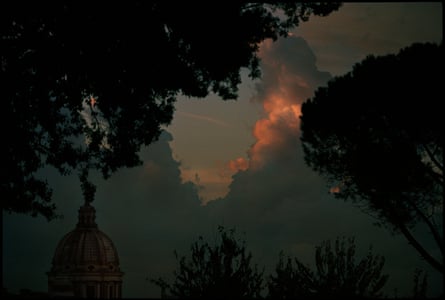
The story exposed the tensions in Australian culture surrounding issues of freedom of expression, censorship and artistic appreciation. Kevin Rudd, the prime minister at the time, called Henson’s work “revolting” and said it had no artistic merit. By contrast, Malcolm Turnbull, then shadow treasurer, owned several Hensons.
The artist lay low during the two weeks of intense media attention, working in his studio. He’s not on social media (he says he lacks the headspace for it) and tried to insulate himself as best he could from the fuss. “Generally, at the centre of that storm, it was quiet. I was just here, working away. But the TV crews were on the streets for two weeks. It was on the front pages and the news every day.
“In retrospect, it was kind of good,” he says. “It made me reinforce all my previous convictions. It didn’t make me think I’d been doing something wrong, or maybe my head’s not in the right place. It reinforced the exact way I was working with the kids I had worked with over the previous 30 to 40 years.”
Not a single child subject or one of their parents complained, Henson says. But yet, “Everyone is lined up, throwing rocks. It’s very important not to harden up. If you develop a hardened casing on the outside as a means of resisting the slings and arrows you are likely to become less sensitive to the beauty around you, so it’s very important to remain soft.”
But it made Henson suspicious of people who claim the moral high ground.
“My default position has become, I suppose you would say, curmudgeonly. The person who everyone else is kicking, I’m more likely to automatically defend. There’s almost no information [out] there about anything but so many opinions, and that sets that righteous tone which drives current affairs, the media and all that other rubbish.”
But, as is clear from our conversation, even though it was broadly those on the left who supported the artist in 2008, and the right – including the Murdoch press – who attacked him, that Henson is no progressive.
Of modern art he says: “If you look at contemporary sculpture, there is this trend to create things that are wildly incongruous, but just for the sake of stepping outside the circle … Anyone can sit down with a piece of paper and write down 10 ideas for things, and if they were executed by good craftsman they would stop people in their tracks, at least for a minute.
“But I don’t think they’d necessarily have any lasting value, so they inadvertently become part of the hit-and-run culture that I’m talking about.”
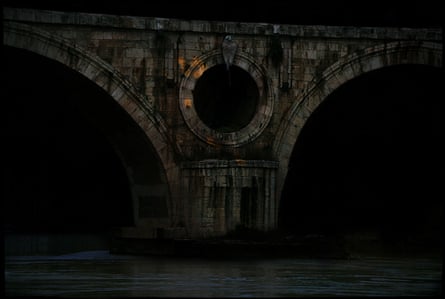
He gives an example: “Just think, if you wanted to be a really groovy sculptor, you could make a life-sized statue of John Howard out of needles, or a battleship out of sardines. That accounts for so much contemporary art – particularly sculpture.”
Modern museums, in an effort to attract the masses, “feel like they have to be like a multiplex cinema or a shopping centre. They have escalators and touch screens and people move through them along flow charts exactly as they would in a modern shopping centre.”
He also hates what he terms “political correctness”. “When someone’s being attacked, until I have information – rather than just opinion – I am inclined to side with that person, which is not a good look. You saw it with Helen Garner and [her book] The First Stone. Of course she’s vindicated.”
Which brings us to sexual politics. “Then you’ve got this hashtag thing – this #MeToo thing – and I could never remember what it was called.”
He mentions Germaine Greer’s controversial opinions about trans people. “These are restless and intelligent people who are going to upset the apple cart and they are going to be wrong in some areas and right in others. It’s the righteous that is the main thing to watch out for. That guy who is out here from Canada recently I have a lot of time for – [academic Jordan] Peterson. He’s great. And it’s this mad idea that he’s out here baiting the lefties.”
If there was a lesson learnt in 2008, it was that politics and art don’t mix.
We return to terra firma: the photographs. The beautiful, still, mysterious and unknowable work he has created for 44 years.
We open Lux et Nox and leaf through it slowly. He names the places where the photographs were shot (he works alone, no assistants): a heavy industrial bridge in west Melbourne, going over the Maribyrnong river; the Great Ocean Road; Hazelwood and the power station lights; a road in Gippsland at night. “Most of it has changed,” he says. “It’s all gone now.”
Of the feelings that the work invokes, Henson most agrees with the term “nostalgia”, although not used pejoratively but as an appreciation that a thing of beauty will pass and, in the knowledge of this, it can be mourned even as the moment is happening – even if it is in full bloom.
In his work, as in life, nothing gold can stay.
